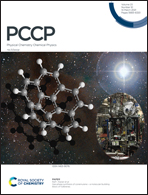Thermal transport by electrons and phonons in PdTe2: an ab initio study†
Abstract
Palladium ditelluride (PdTe2) is expected to have great promise in electronics and quantum computing due to its exotic type-II Dirac fermions. Although the electronic structure and electrical transport properties of PdTe2 have been comprehensively investigated, its thermal transport properties have not been well understood yet. In this work, we study the lattice and electronic thermal conductivity of PdTe2 using mode-level ab initio calculations. We find its thermal conductivity is ∼35 W m−1 K−1 on the a-axis at room temperature, mainly attributed to the strong lattice anharmonicity and electron–phonon interactions. The lattice thermal conductivity is smaller than 2 W m−1 K−1 and it only contributes a small ratio of ∼5% to the total thermal conductivity. The electronic thermal conductivity is relatively small compared to common metals mainly due to the strong electron–phonon scattering. The Lorenz ratio has a large deviation from the Sommerfeld value below 200 K. In addition, the mean free path of the phonons is about five times larger than that of the electrons. Our results provide a thorough understanding of the thermal transport in PdTe2 and can be helpful in the design of PdTe2-based devices.



 Please wait while we load your content...
Please wait while we load your content...